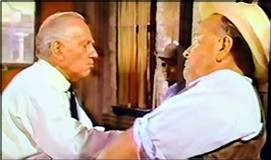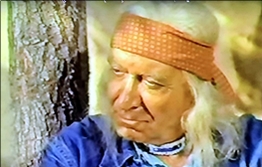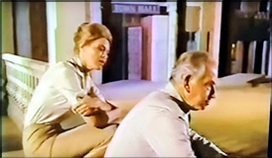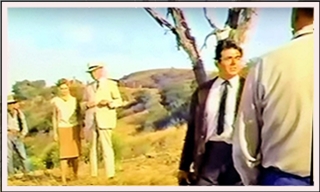Fri 26 May 2023
A TV Episode Review by David Vineyard: BOB HOPE CHRYSLER THEATER “A Killing at Sundial” (1963).
Posted by Steve under Reviews , TV Drama[4] Comments

BOB HOPE CHRYSLER THEATER. “A Killing at Sundial” NBC, 04 October 1963 (Season One, Episode One). Stuart Whitman, Melvyn Douglas, Angie Dickinson, Joseph Caliea, Robert Emhardt, Malcolm Atterbury. Teleplay: Rod Serling. Directed by Alex Segal. Currently available for streaming on YouTube (see below).
Sundial is a small Southwestern town slowly wilting under a drought that has bankrupted the town Boss Pat Konkle (Melvyn Douglas) has put most of the residence deep in debt and burdened with unpaid mortgagees. As the hot dusty town threatens to dry up and blow away under the onslaught of poverty and heat, an unlikely savior appears: Billy Cole (Stuart Whitman), an Indian whose father the town lynched before driving Billy out of town years earlier.
Billy is bitter, ironic, and recently oil rich, interested only in putting a burr under Konkle, not even in renewing his one time interest in Konkle’s beautiful daughter Susan (Angie Dickinson).

The only person in the world he cares about is Cagewa (Joseph Caliea), an old chief who was mentor and savior to Billy after his father was lynched, and Cagewa fears what it is Billy has come back for.
That something is revealed at an impromptu service at his father’s unmarked grave Billy invites the town folk to. He has bought all their mortgages and save the town for a price — Pat Konkle dies before morning.
How, who, none of that concerns Billy. All the wants is Konkle dead before the next sunrise.

Cagewa is horrified, as much by the willingness of everyone to do the job. Susan tries to explain her father is a broken man who has lost everything. None of that matters to Billy. He will watch as the day winds down and the long hot night rolls by while Konkle becomes more and more aware his many years of Boss rule have won no champions, no friends.
He is going to die before morning comes.

“Killing at Sundial†was the first episode of the Bob Hope Chrysler Theater in the first season in color in 1963. Aside from a strong cast, it featured a strong teleplay by Rod Serling, touching on familiar Serling elements such as racism, hate, revenge, intolerance, small town prejudice, and broken men, Billy by his hate, Konkle by his arrogance and fear, the town by their greed and desperation.
The anthology format was made for Serling, and throughout the Fifties and Sixties, he and writers like Abby Mann and Paddy Chayevsky brought high drama to the format, with Serling himself becoming a celebrity hosting The Twilight Zone and as screenwriter for films like Seven Days in May.

Despite the usual White men in Red face common to the era, this one has a strong narrative line, and fine performances all around with Douglas getting to do some fine emoting as he falls apart ,and Caliea’s quiet dignified Cagewa stealing the whole thing as he did many a film in his long career.
The finale is powerful even if predictable, ending on a surprisingly dark note for an anthology series episode from this era.

Perhaps too on the nose for modern audiences at the time, there was a freshness and power to this sort of thing, a too rare look at a darker side of the uniform and bright world many of us had grown up in. As the optimism of the era gave way to questions and fears, even the relatively sedate world of the small screen began to acknowledge that the safe prosperous world we grew up in was not the only one.
“Killing at Sundial†offers a glimpse of sunny hell, and as with most things Rod Serling did, it is worth catching.

May 26th, 2023 at 10:12 pm
Fantastic, cast and subject matter. The Climate
change cretins could re-issue this on Blu ray as a
Picture of Things To Come. H.G. Wells territory.
May 27th, 2023 at 5:30 am
Reminiscent of Friedrich Durrenmatt’s 1956 play THE VISIT, in which a wealthy woman offers the people of her hometown a fortune if they would kill a former lover who had jilted her years ago.
May 27th, 2023 at 2:22 pm
I dislike bringing this up, since obviously I am far from the truth of it, but in producing scripts for TWILIGHT ZONE, Rod Serling was often accused of unconscious plagiarism. Read for example
https://lithub.com/did-the-creator-of-the-twilight-zone-plagiarize-ray-bradbury/
May 28th, 2023 at 12:00 am
There is an obvious resemblance to Durrenmatt’s story (filmed with Ingrid Bergman and Anthony Quinn), but Serling’s tale is more inspired by than plagiarized (you can’t copyright an idea). There is no racial element in the Durrenmatt tale and this one is filled with elements common to Serling’s past work, some mentioned in the review. You can look at Serling’s past work and find most of the tropes of this film.
Durrenmatt is more ironic and paradoxical than outraged, the latter one of Serling’s strong points. Durrenmatt is saying this is what we are. Serling is asking why aren’t we better.
I considered mentioning the Durrenmatt book and play, but honestly decided it was a blind alley and more than a bit misleading.
I don’t doubt the story was inspired by Durrenmatt, but only the concept, not the execution and the theme of the Faustian bargain is hardly new. Westerns pretty much beat Durrenmatt and Serling to this plot by a mile.
Serling answered the Bradbury accusations at the time and pointed out that Bradbury’s stories themselves almost defied adaptation with any fidelity, a point I think made pretty well by most episodes of RAY BRADBURY THEATER, THE MARTIAN CHONICLES mini series, and THE ILLUSTRATED MAN film.
My own opinion is the TWILIGHT ZONE adaptation of “I Sing the Body Electric” makes Serling’s point.
At least one Bradbury attributed TZ story is as much DEAD OF NIGHT as Bradbury. Mind you I agree Serling sailed too close to Bradbury in a few stories, but I suspect his version was better drama than Ray’s would have been, if Ray’s was more literary and closer to art.